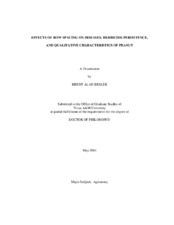Effects of row spacing on diseases, herbicide persistence, and qualitative characteristics of peanut
Abstract
Field and greenhouse studies were conducted to assess the effects of row-spacing on diseases, weed control, herbicide persistence and plant development in peanut. Tebuconazole, when averaged across cultivars and row spacing, effectively controlled white mold (57%) and rust (58%). Azoxystrobin also controlled white mold (58%) and controlling rust (44%). Both fungicides reduced leaf spot severity in the conventional and twin rows when compared to untreated plots. Twin rows showed a 10% yield increase compared to the conventional planting. Both diclosulam and imazapic, when applied to twin rows at the full and reduced rate, provided better yellow nutsedge control than when applied to the conventional row. Twin rows yielded higher than the conventional rows when averaged across herbicides in one year. All full rate herbicide treatments enhanced yield over the untreated check. Diclosulam and imazapic treated soil sampled 60 DAP adversely affected all four crops. The advantage of planting peanuts in twin rows to reduce diclosulam and imazapic residual concentrations was not apparent. Georgia Green and Tamrun 96 planted in twin rows at three of the four locations in 1999 and 2000 yielded higher than peanuts planted in conventional rows. Yields were comparable to twin-row spacings that had higher plant densities. Georgia Green and Tamrun 96 planted in conventional rows, in most cases, had higher yields than narrow-rows. Measurements for plant diameter, pod distribution, and main stem length were higher with Tamrun 96 at most row spacings and planting densities compared to the respective Georgia Green planting densities and row spacings. Both cultivars when planted in twin or narrow rows at all planting densities did not enhance maturity when sampled late season. Georgia Green and Tamrun 96 when planted in conventional rows had the most pods/plant compared to the narrow and twin row spacing. No clear evidence was found to suggest that peanuts grown in narrow or twin rows increased white mold disease incidence. Grades for Georgia Green were higher than Tamrun 96 when planted in twin rows at the standard planting density. Tamrun 96 in twin rows at the standard planting density had a higher grade than when planted in conventional rows at the low planting density.
Citation
Besler, Brent Alan (2003). Effects of row spacing on diseases, herbicide persistence, and qualitative characteristics of peanut. Doctoral dissertation, Texas A&M University. Texas A&M University. Available electronically from https : / /hdl .handle .net /1969 .1 /2188.


